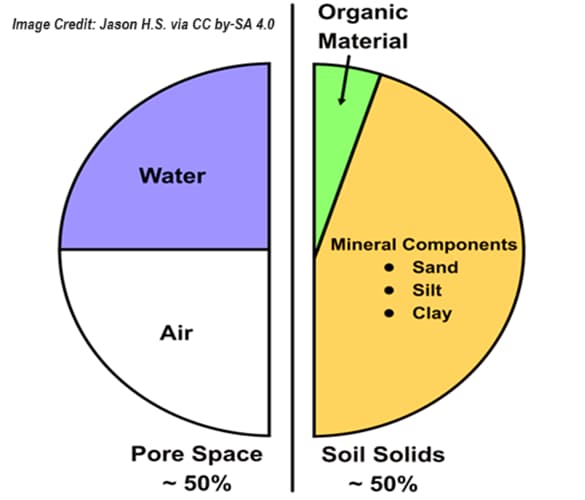- Home
- Tips to Grow Palms
- Planting Palm Trees
- Soil for Palms
Best Soil for Palm Trees
Complete Guide to Healthy Growth
Soil for palm trees is very important. Why?
Palm trees can seem tough, but their roots are pretty picky.
- The right soil determines how well palms absorb water, nutrients, and oxygen.
- Planting palms in the wrong soil can mean yellow leaves, weak growth, and even root rot.
👉 In this guide, you’ll learn: What Is the Best Soil for Palm Trees?
- The ideal soil type and pH for palm trees.
- How to test your soil’s pH at home (simple video method).
- Recommended palm soil mixes you can buy.
- Easy DIY soil recipes you can make yourself.
Feeling overwhelmed by so many palm trees?
You're not alone. We Understand your headaches! At Mission: Palm Trees you'll find clear answers to questions & Step-By-Step Guidance, from real people. With solutions to help. No puzzling shoptalk. No tiring research. So it's easy & fun for you.
Why the Right Soil Matters for Palm Trees
Soil conditions play a role for successful palm growth.
- The best soil for nearly all palm trees is on the acidic side (pH 6.0–7.0).
- It should be well-draining, holding some moisture without staying soggy.
- It may be beneficial to use proportional blends of:
- Peat, especially sphagnum decreases pH.
- Humus, decomposed plant material helps soil aeration and moisture retention.
- Perlite, volcanic glass bits that expand with super-heat. Neutral pH of 7.0, it's porous and holds water.
Believe me, I've learned about these details, as our Tucson alkaline soil is definitely out of the ideal range for palms.
Mission: Palm Trees is made possible by readers like you! If you purchase via a link/ ad here, we may earn a small commission. At no added cost to you. Thanks for your support! Learn more>
With knowing that, many palms are pretty adaptable to most soils. What soil type is in your property?
- Sandy soil drains water quickly. You may need to add some organic matter.
- Loamy soils drain water moderately. Excellent for many palms.
- Clay soils drain water slowly. Planting a Palm in clay soil may cause Problems. You could add a bit of Rich Soil Organics but avoid adding sand. SEE MORE HERE> [use Outdoors as anchor.]
 Overall Make-up of the Average Soil
Overall Make-up of the Average SoilUnderstanding Soil pH for Palm Trees
Soil pH affects how easily palms absorb Their Needed Nutrients like magnesium, potassium, and iron.
Here's Why and How to Test Your Soil’s pH at Home:
- Too alkaline (>7.5) → nutrient lockout → yellowing leaves.
- Too acidic (<5.5) → root damage → stunted growth.
- Ideal range → 6.0 to 7.0.
These ranges are discussed in detail in Broschat & Meerow's Ornamental Palm Horticulture on pages 101-105.
DIY Testing for Your Soil’s pH at Home
Easily done with on-hand ingredients!
In just a few minutes, you can test your soil using a DIY vinegar-and-baking-soda method.
See if that works for you. Or you can use A Store-Bought Kit.
What is the Best Soil Mix for Palm Trees?
If you’re potting palms or planting in outdoor areas that may need Soil Amendments (defined here), buying a Ready-Made Palm Mix saves time.
Top options include:
- Palm & Cactus Potting Mixes (well-draining, look for ingredients).
- Tropical Plant Soil Mixes (often include perlite).
- Quality Indoor Palm Mixes (extra organic matter for moisture control).
👉 Choose a Mixture That Mentions “Well-Draining.”
👉 Avoid those with any heavy clay percentages.
👉Avoid soils that compact easily, preventing good aeration.
DIY Palm Tree Soil Mix (Easy Recipes)
The best DIY soil for palm trees in containers Has Sand, Organics and Bark.
Then we must ask if it's helpful to amend native soil with sand and compost for outdoor palms. We have some tips for outside soils.
If you like more control of the ingredients when Planting a Palm we have a simple recipe for you.
For Container Palms:
- 2 parts peat or Coconut Coir Dust (we've used this one)
- 1 part sand mix
- 1 part pine or cypress bark chips
Preparing Soil for Planting Palm Trees Outdoors
For Outdoor Palms (with heavy clay soils):
- Remember that many palms can do fine in clay soils. Use a Palm Tree Guidebook to see your own palm's soil requirements.
- Do not mix in sand, as the combo of sand & clay can end up concrete-like.
- Gypsum can be helpful if you have dispersant clay soil, but not really for non-dispersant clay. How to tell the difference?
- Scoop a hand-full of soil, placing it into water & wait several minutes.
- If the water clouds up, some clay is dissolving = dispersant soil.
- In non dispersant soil, the lump of soil just sits there in clear water.
- But remember typical clay soils are not one extreme or the other. The more your clay soil clouds the water, the more that Gypsum amendment can help.
Other Outdoor Soil Types
Meerow & Broschat in Ornamental Palm Horticulture say that with most palms, outdoor native soils work fine. As long as the pH is correct. Plus there are five more important points they advise:
- Plant your palm in a hole that's twice as wide as the pot/root ball.
- Native soil amendments are usually unnecessary. Minimal organics could be used. But never composted manure.
- Refill the outer hole with the soil you've removed.
- Fully Properly Water your newly planted palm
- Add mulch to help regulate moisture and add nutrients as it deteriorates.
Tip: Adding Fertilizer after planting is often helpful. They may need a fertilizer with higher Nitrogen content at first, while establishing.
Don't Miss Related Resources on Mission: Palm Trees
The secret to thriving palms isn’t luck - it’s soil. These other resources we have may help you further. Click each one to view:
FAQs About Palm Tree Soil
Do palm trees like acidic or alkaline soil?
Do palm trees like acidic or alkaline soil?
Palm trees prefer slightly acidic soil with a pH between 6.0 and 7.0. See More About pH Effects.
What is the best soil for palm trees in pots?
What is the best soil for palm trees in pots?
A lightweight, well-draining palm mix works best. Avoid heavy soils. More About Soil for Palms>
Can I use cactus mix for palm trees?
Can I use cactus mix for palm trees?
Yes, cactus mix might work well since it's well-draining. Typically, cacti do well with a pH range similar to palms. But cacti also do fine with a bit more acidity - from 5.5 to 7.0. We've seen potting soil labeled for cacti, succulents and palms. Yet, that same brand doesn't list ingredients.
It's much better to use soil prepared for palms. If you must use cactus mix for your palm, be sure ingredients are listed to help evaluate the contents.
How do I know if my soil drains well?
How do I know if my soil drains well?
Dig a hole 12in/30.5cm deep & nearly as wide, at a time where lots of rain hasn't recently fallen. Then:
- Fill it with water and wait for it to drain away.
- Then refill water into the hole.
- Wait 15 minutes. Next measure from the top of the water to the top edge of the opening.
- Multiple that number by 4 to use an hourly calculation.
- If your hourly calculation shows at least 4in/10.1cm - you have well-draining soil.
- If a little less than that, you could use soil amendments to improve it.
- If it's only 1-2in/2.5-5cm/\ then it needs much improvement in drainage.
TIP: If you have well-draining soil, next use this hole for Your Palm Planting hole - you've already begun!
Takeaways for Soil for Palm Trees
Ready to grow healthier, greener palms? Start with the soil—and your trees will thank you.
- If you’re planting in the ground, test your soil pH and amend as needed.
- For pots, choose a mix designed for palms or use the DIY recipes above.
- Remember: well-draining + slightly acidic = happy palms.
The proper soil for palm trees, especially concerning the right pH is the most important thing!

